ID3AS Blog
Target Impression Share

Everyone wants to get results from paid advertising… In order to maximize reach for your paid search campaigns, Google Ads recently released a new smart bidding strategy. They call it Target Impression Share.
This new strategy is specifically designed to maximize your share of search ad impressions against the competition. As Google puts it, it will “show in a certain percentage of eligible auctions.”
Google gave a little more insight:
For example, let’s say you want your ad to show 100% of the time when a user searches for your brand. You can set the Target Impression Share to 100% and the system will then try to show your ad on 100% of auctions in that campaign.
This bid strategy can also be useful in raising awareness of your brand. Let’s say you run ads for a local shoe store but you’re competing with larger shoe stores. You could focus on Target Impression to ensure your brand is showing up when customers are conducting important searches nearby.
With target impression share bidding, Google’s system now automatically sets bids to achieve the shared goal. You can set one of three placement options for this strategy: the very top of the page (position one), top of the page (above the organic results), or anywhere on the page (above or below the organic results).
Just as other smart bidding strategies are, target impression share is set at the campaign level. You want to be sure to include only keywords that make perfect sense for this goal in the campaign. After you have chosen the placement option you want to aim for, you can set the impression share percentage target, reaching as high as 100%.
When it comes to setting the bid limit, Google warns businesses and users of the dangers and risks of setting it too low: it can choke the bids needed to reach your goal.
This is Google’s fourth smart bidding method to automate the bidding process and the first method that is aimed primarily at reach and awareness.
In early November, Google added reporting on these position metrics in the interface to get people thinking less about the average position, and more in terms of where on the page — very top, above the fold, below the fold — they appear as a better indicator of the impact of position on your performance.